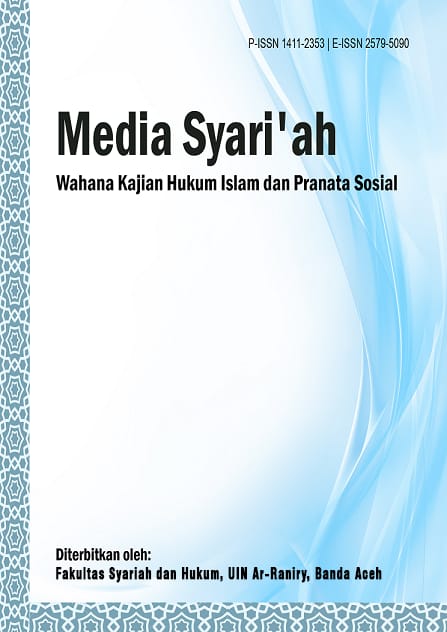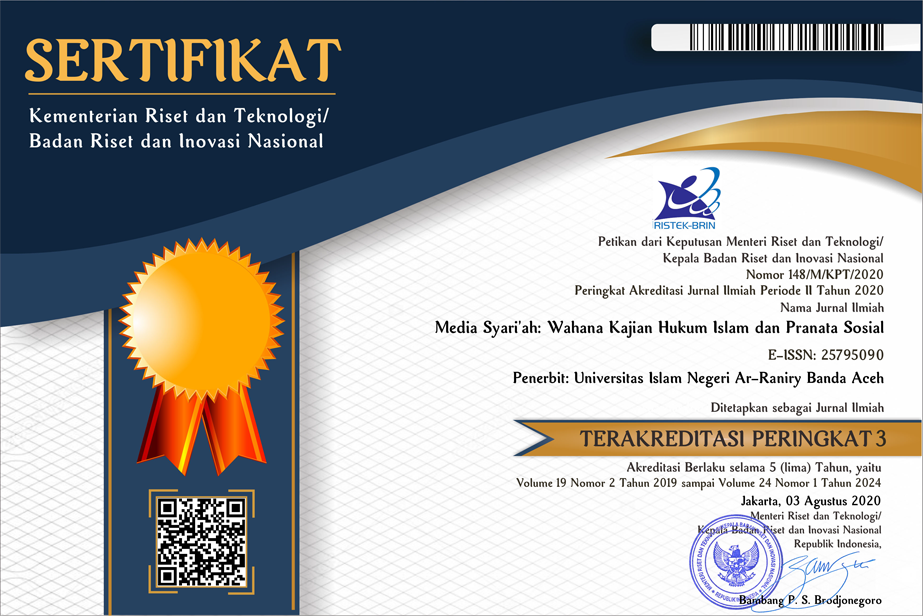Isbat Nikah Siri dalam Putusan Hakim Mahkamah Syar'iyah Lhoksukan
DOI:
https://doi.org/10.22373/jms.v23i1.9181Keywords:
isbat nikah, nikah siri, putusan hakimAbstract
Positive law only limits marriage isbat to marriages that occurred before Law no. 1 of 1974 because there is no rule requiring registration. Meanwhile, unregistered marriages that occur after the regulation cannot carry out isbat marriage, because the law only limits it before the enactment of Law no. 1 of 1974. However, the Compilation of Islamic Law provides space as Article 7 paragraph (3) letter e which reads that marriages are carried out by those who do not have marriage barriers according to Law no. 1 of 1974. Article 7 has provided a very broad absolute competence regarding isbat marriage, even though KHI is not included in the hierarchy of Legislation. Judges are given the flexibility to perform ijtihad for the benefit of all parties. This article is the basis for consideration of the Lhoksukon Syar'iyah Court judges in granting the application for isbat marriage for unregistered married couples, namely number: 131/Pdt.P/2019/MS.Lsk. number: 313/Pdt.P/2019/MS.Lsk. For this reason, this paper wants to answer the question of how the judges of the Lhoksukon Syar'iyah Court considered the reasons for the isbat of unregistered marriages, and what was the legal status of the judge's determination of the isbat of marriages for unregistered married couples. The method used is descriptive analysis method with a qualitative approach. The research approach is juridical normative and juridical sociological, using the theory of legal protection. Then use the theory of maqāṣid syarī'ah to realize goodness while avoiding evil, or take advantage and reject harm. The results of the study stated that the consideration of the judges of the Lhoksukon Syar'iyah Court in the case of isbat marriage for unregistered married couples was in accordance with the laws and regulations, the judge was also not rigid in ijtihad but considered sociological and problematic aspects.
Hukum positif hanya membatasi isbat nikah pada perkawinan yang terjadi sebelum UU No. 1 Tahun 1974 karena belum ada aturan mewajibkan pencatatan. Sedangkan nikah siri yang terjadi setelah aturan itu tidak dapat melakukan isbat nikah, karena Undang-Undang hanya membatasi sebelum berlakunya UU No. 1 Tahun 1974. Namun Kompilasi Hukum Islam memberi ruang sebagaimana Pasal 7 ayat (3) huruf e yang berbunyi perkawinan yang dilakukan oleh mereka yang tidak mempunyai halangan perkawinan menurut UU No. 1 Tahun 1974. Pasal 7 ini telah memberikan kompetensi absolut yang sangat luas tentang isbat nikah, padahal KHI tidak termasuk dalam hierarki Peraturan Perundang-Undangan. Hakim diberikan keluasan untuk berijtihad demi kemaslahatan semua pihak. Pasal inilah menjadi dasar pertimbangan Majelis hakim Mahkamah Syar’iyah Lhoksukon dalam mengabulkan permohonan isbat nikah bagi pasangan nikah siri, yaitu nomor: 131/Pdt.P/2019/MS.Lsk. nomor: 313/Pdt.P/2019/MS.Lsk. Untuk itu tulisan ini ingin menjawab pertanyaan bagaimana pertimbangan Hakim Mahkamah Syar’iyah Lhoksukon terhadap alasan isbat nikah siri, dan bagaimana status hukum terhadap penetapan Hakim mengenai isbat nikah bagi pasangan nikah siri. Metode yang digunakan adalah metode deskriptif analisis dengan pendekatan kualitatif. Adapun pendekatan penelitian bersifat yuridis normatif dan yuridis sosiologis, dengan menggunakan teori perlindungan hukum. Kemudian menggunakan teori maqāṣid syarī‘ah untuk mewujudkan kebaikan sekaligus menghindarkan keburukan, atau menarik manfaat dan menolak mudarat. Hasil penelitian menyebutkan bahwa pertimbangan hakim Mahkamah Syar’iyah Lhoksukon dalam kasus isbat nikah bagi pasangan nikah siri telah sesuai dengan peraturan perundang-undangan, hakim juga tidak kaku dalam berijtihad tetapi mempertimbangkan aspek sosiologis dan masalahat.
References
A. Gani, Burhanuddin, and Nisrina Nisrina. 2020. “Keengganan Pasangan Suami Istri Dalam Melakukan Itsbat Nikah (Studi Kasus Di Kecamatan Bandar Baru, Kabupaten Pidie Jaya).” Media Syari’ah 20(1). doi: 10.22373/jms.v20i1.6505.
Ali, Muhammad Daud. 2012. Hukum Islam : Pengantar Ilmu Hukum Dan Tata Hukum Islam Di Indonesia. Jakarta: Rajawali Pres.
Anshary, M. MK. 2010. Hukum Perkawinan Di Indonesia. Yogyakarta: Pustaka Pelajar.
Asmawati. (1999). Dosen Hukum Perdata Fakultas Hukum Univ. Jambi. Ilmu Hukum, 6(4).
Badrum, Mukhtaruddin. 2013. “Legalisasi Nikah Sirri Melalui Itsbat Nikah Menurut KHI (Studi Kasus Pada Pengadilan Agama Sulawesi Selatan Perspektif Fikih).” UIN Alauddin, Makassar.
Candra, Adeka. 2020. Wawancara Hakim. Lhoksukon.
Departemen Pendidikan Nasional. n.d. Kamus Besar Bahasa Indonesia.
Dermawan, Riki. 2020. Wawancara Hakim. Lhoksukon.
Ditjen Bimbingan Masyarakat Islam Kemenag RI. n.d. “Himpunan Peraturan Perundang-Undangan.”
Fauzi, A. C. (2018). Kedudukan Hukum Itsbat Nikah Poligami Sirri. Jurnal USM Law Review, 1. http://journals.usm.ac.id/index.php/julr/article/view/2234
Hasanah, Raudhatul. 2017. “Analisis Sosiologis Terhadap Itsbat Nikah Di Pengadilan Agama Pamekasan.” UIN Sunan Kalijaga, Yogyakarta.
Mardani. 2015. Hukum Islam Kumpulan Peraturan Tentang Hukum Islam Di Indonesia. Jakarta: Kencana.
Mudar, Andi Nadir. 2018. “Fenomena Itsbat Nikah Terhadap Perkawinan Yang Dilakukan Setelah Terbitnya Undang-Undang Nomor 1 Tahun 1974 Tentang
Perkawinan (Studi Di Pengadilan Agama Andoolo).” Jurnal Zawiyah Jurnal Pemikiran Islam 4.
Muhammad, Syed Bin Syed Zakaria. 2016. “Analisis Enakmen Keluarga Islam (Perak) 2004 Terhadap.” UIN Ar-Raniry, Banda Aceh.
Munthe, Riswan, and Sri Handayani. 2017. “Kajian Yuridis Permohonan Itsbat Nikah Pada Pengadilan Agama Medan.” Jurnal Pendidikan Ilmu-Ilmu Sosial 9(No. 2).
Nazlianto, Riza, and Ekawati. 2017. “Pertimbangan Hakim Tentang Putusan Itsbat Nikah Setelah Berlakunya Undang-Undang Nomor 1 Tahun 1974 Tentang Perkawinan (Analisis Ptusan Nomor : 0036/Pdt.P/2016/MS.Ttn)).” Jurnal Al-Mursalah 3(No. 1).
Ramlah. 2015. “Legalisasi Hukum Itsbat Nikah Terhadap Perkawinan Yang Tidak Tercatat Sebagai Wewenang Peradilan Agama.” Jurnal Ilmiah Universitas Batanghari 15(No. 1).
Republik Indonesia. 1974. “Undang-Undang Nomor 1 Tahun 1974.” Lembaran Negara.
Rofiq, Ahmad. 1995. Hukum Islam Di Indonesia. Jakarta: Raja Grafindo Persada.
Safrizal. 2016. “Implementasi Itsbat Nikah Terhadap Perkawinan Siri Ditinjau Dari Hukum Positif (Studi Di Mahkamah Syar’iyah Meulaboh).” UIN Ar-Raniry, Banda Aceh.
Shihab, Quraish. 2007. Wawasan Al-Qur’an. Bandung: Mizan.
Sulistiani, Siska Lis. 2018. “Analisis Yuridis Aturan Itsbat Nikah Dalam Mengatasi Permasalahan Perkawinan Sirri Di Indonesia.” TAHKIM, Jurnal Peradaban Dan Hukum Islam Vol. 1(No. 2).
Syarifuddin, Amir. 2009. Hukum Perkawinan Islam Di Indonesia. III. Jakarta: Kencana.
Wafa. 2020. Wawancara Hakim. Lhoksukon.
Yunus, Ahyuni. 2020. Hukum Perkawinan Dan Itsbat Nikah. I. Makassar: Humanities Genius.
Yunus, M. (2018). Pelaksanaan Itsbat Nikah Massal Pasangan Suami Istri Tanpa Akta Nikah Di Kabupaten Luwu Utara. Tahkim (Jurnal Peradaban Dan Hukum Islam), 1(2), 1–22. https://doi.org/10.29313/tahkim.v1i2.3898
Downloads
Published
Issue
Section
License
MEDIA SYARI'AH: Wahana Kajian Hukum Islam dan Pranata Sosial has CC-BY-SA or an equivalent license as the optimal license for the publication, distribution, use, and reuse of scholarly work. Authors who publish with this journal agree to the following terms:
1. Authors retain copyright and grant the journal right of first publication with the work simultaneously licensed under a Creative Commons Attribution-ShareAlike 4.0 International License that allows others to share the work with an acknowledgment of the work's authorship and initial publication in this journal.
2. Authors are able to enter into separate, additional contractual arrangements for the non-exclusive distribution of the journal's published version of the work (e.g., post it to an institutional repository or publish it in a book), with an acknowledgment of its initial publication in this journal.
3. Authors are permitted and encouraged to post their work online (e.g., in institutional repositories or on their website) prior to and during the submission process, as it can lead to productive exchanges, as well as earlier and greater citation of published work (See The Effect of Open Access).
You are free to:
Share — copy and redistribute the material in any medium or format.
Adapt — remix, transform, and build upon the material for any purpose, even commercially.
The licensor cannot revoke these freedoms as long as you follow the license terms.
All papers published in MEDIA SYARI'AH: Wahana Kajian Hukum Islam dan Pranata Sosial are licensed under a Creative Commons Attribution-ShareAlike 4.0 International License.




.png)


.png)
.png)
.png)



